A brief about Ham, Bacon & Gammon
What is Ham
Ham refers to the specific cut of pork meat that is taken from the hind leg/ back thigh of a pig , which is then preserved through the process of salting, smoking, or drying. In many parts of the world ham is occasionally salted, seasoned with a dry spice & smoked. Ham may be fresh, cured, cured & smoked

Pic source:- https://www.kitchenparade.com/2010/03/ham-101-what-to-know-before-buying-ham.php
Difference
In the United States, mass-produced supermarket hams—often called city hams—typically come brined and precooked. The brine, water flavored with salt, sugar, and other seasonings, gets injected into the meat, infusing it with flavor and juiciness while also helping to preserve it. A fully cooked ham like this will be labeled “ready to serve” or “ready to eat.”
All types of ham start out as a roast from the hind leg of a hog. This is called a fresh ham. Before it is prepared it is no different than any other pork roast. How it gets to be a ham is something of a complicated story. Hams are prepared in several different ways. They can be aged, cured, smoked, or cooked.
Ham that are dry salted has the best flavour and are the most tender but other hams are plunged straight into brine,or cured in a way that combines both methods. Curing time can as long as 2 months. Salt used for curing is usually mixed with sugar an assortment of
spices, particularly pepper and with nutritive preservatives that add Pink colour and protect meat from botulism toxins.
Ham types & Style: –
Ham usually comes to market in two basic styles:-
- City Ham
- Country Ham
City hams:-The most common in grocery stores, tend to be wet brine-cured, are often smoked, and almost always come fully cooked. City homes can be boned or boneless ham.
Country Ham:- are usually dry-cured hams, such as Virginia or Smithfield hams, take a more artisanal approach akin to Italian prosciutto or Spanish serrano, which involves lengthy hanging in controlled temperatures.
Hams are prepared in several different ways. They can be aged, cured, smoked, or cooked. Boneless hams often contain molded bits of pressed meat.
Cured Ham:-
The Ham which is wet or brined is called Cured Ham. This process involves injecting the ham with a combination of salt, sugar, sodium nitrate, sodium erythorbate, sodium phosphate, potassium chloride, water and/or flavourings. The ham is then cooked to an internal temperature of 150 F. The combination of the chemical brine and the cooking will kill off bacteria and make a ham.
Dry-Cured Ham:- It is a combination of salt curing, air drying, and sometimes smoking, depending on the meat and the desired product. For dry-cured ham, pig or wild boar, hind legs are packed in salt and left for up to two months during which much of the moisture is wicked from the ham. After a thorough washing, the ham legs are hung in a very dry, cool, dark room in which the reminder of the moisture evaporates. The air-drying process can take up to 18 months, and the resulting dried ham can be stored for up to a year.
Example of dry cured Ham:-
| Prosciutto di Parma- Prosciutto di Parma can only be produced from the hind legs of specially selected heritage breed pigs raised in 11 regions of Italy. Prosciutto di Parma can only be produced from Italian-born and bred pigs raised according to the highest standards, on which they are monitored, inspected, and traced | 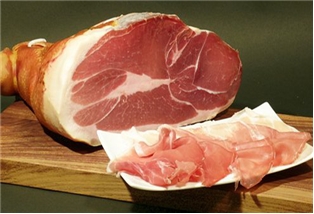 |
| Jamon Serrano/Iberian Ham:-is a kind of dry-cured ham produced all around Spain. It is one of the most globally recognized food items of the Spanish cuisine. It is also regularly a component of tapas. | 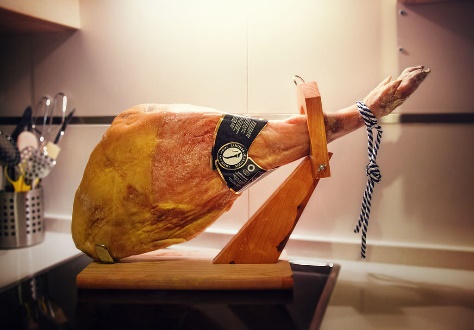 |
| Bayonne ham or jambon de Bayonne is a cured ham which is a minimum of 7 months old, with most being 9 or 10 months before it is offered for sale, and it will keep for up to another year if kept in a cool (8 °C), dry atmosphere. | 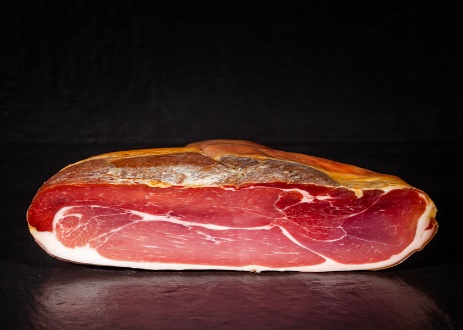 |
| Black Forest Ham is a German dry-cured and smoked ham. Black Forest ham can take up to three months to produce. Raw ham is salted and seasoned with garlic, coriander, pepper, juniper berries and other spices. After curing for two weeks, the salt is removed and the ham aged an additional two weeks. It is then cold-smoked using sawdust and fir or juniper brush at a temperature of not more than 25°C (77°F) for several weeks, becoming almost black on the outside and acquiring much of its distinctive flavor. It is then air-cured for at least two weeks before sale. |  |
- Wet-Cured Ham is the most popular ham in the US. It is meat that is usually skinned and cured by soaking in a brine or injecting it with a brine. A brine is a salt and water solution with some or all of these ingredients: Sugar, sodium nitrite, sodium nitrate, sodium erythorbate, sodium phosphate, potassium chloride, liquid smoke, and other flavorings. The ingredients will appear on the label. Some wet-cured hams are pre-cooked and labeled as “ready to eat”. Some are sold uncooked as “cook before eating”.
- Canned Ham can contain scraps and pieces of meat pressed and formed to fit in the can and may contain up to 10% water or broth. Usually under three pounds. Canned ham labeled “shelf stable” can be stored at room temp for three years. I have no idea how to cook them and no interest in learning.
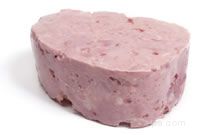
- City Ham. An unofficial term used to describe wet-cured ham. It is usually sold in a plastic bag in the refrigerator case and labeled “ready to cook”, “partially cooked” or “ready to serve”. The better city hams also say “ham in natural juices”
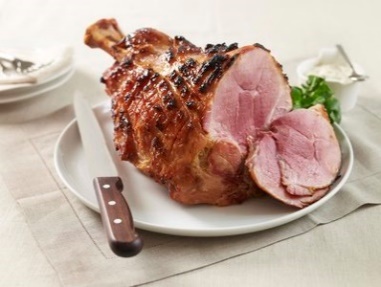
- Ham Steak is usually a cross section slice of wet-cured smoked ham with a round section of thigh bone in the middle. It is good when grilled quickly with or without a glaze or sauce.
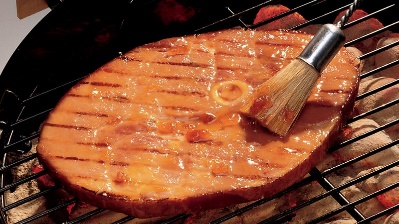
What Does Ham Taste Like?
Unadorned, the slightly sweet/smoky flavor and soft texture of cured city ham tastes just like the sliced cold cuts found in the deli counter. But the mild meat readily takes on the flavor of whatever glaze you use to dress it. Fresh ham tastes similar to pork tenderloin, while dry-aged country ham is quite salty with a chewier, more dense texture.
Varieties
Ready-to-eat hams are available in both boneless and bone-in styles; a bone-in ham is superior in every way but one: ease of slicing. The bone adds flavor and moisture and enhances the presentation. Moreover, a ham bone is an exceptionally desirable piece of culinary swag. You can simmer it with black-eyed peas or collard greens (or both), use it to make ham stock or soup, or flavor slow-cooker jambalaya with it or use it for a one-pot meal like white beans and smoked ham shank.
Because bone-in hams are hard to cut, spiral-cut hams came about. Cut by a machine at the processing plant or a butcher, this technique slices a bone-in ham in one continuous spiral, leaving the meat on the bone in its original shape. Instead of carving a ham by hand, you simply cut the meat perpendicular to the bone to have perfect, consistent slices.
A basic boneless ham will be shaped like an oval and come sealed in plastic or foil. Your best bet with a boneless ham is a spiral-sliced ham because you’re getting an entire quarter of a ham—either the inside or outside of the leg muscle, from the shank (bottom) or butt (top) end.
Another option is a semi-boneless ham, which has had the aitch (hip) bone and tailbone removed, leaving only the thigh bone. Semi-boneless hams come in whole or half (butt or shank).
Storing Ham
The length of time you can safely store ham depends on the variety you purchase. Ready-to-eat whole hams can be stored in the refrigerator for a week in the original packaging. Ready-to-eat half hams in the store packaging should be used within three to five days, though.
A fresh uncured, uncooked ham lasts for three to five days in the refrigerator, as does a spiral-cut ham. Vacuum-sealed packaging can increase the storage time of any ham variety, though.
Leftover cooked ham should be stored in an airtight container in the refrigerator and eaten within three days. Most ham retains optimum quality in the freezer for only a month or two.
Nutrition Facts
The following nutrition information is provided by the USDA for a one-ounce slice (28g) of ham.
- Calories: 37
- Fat: 1g
- Sodium: 63mg
- Carbohydrates: 0g
- Fiber: 0g
- Sugars: 0.6g
- Protein: 5g
Health Benefits of Ham
Ham is a good source of protein. It is also a very good source of selenium, phosphorus, zinc, vitamin B6, B12, thiamin, riboflavin, niacin, and choline. Depending on the variety and cooking method, ham can also be low in fat.
Wines That Pair Ridiculously Well with Ham
Basics to Pairing Wine with Ham
Ham, with its sweet-and-salty richness, pairs best with wines that have a touch of sweetness, plenty of acidity and bold fruit. Great ham-wines include Riesling, Moscato, Chenin Blanc, Rosé, Lambrusco, Grenache, and Zinfandel, sparkling wine, sheery & Dry madeira.
- Jamón Ibérico with dry Sherry
- Prosciutto with Moscato d’Asti
- Speck with Rheingau Riesling
What is Bacon?
Bacon is salt-cured meat cut from a pig’s belly or back. bacon is a certain style of salt-cured pork, which means it’s either brined (wet) or salted (dry) prior to cooking and serving. The process preserves the meat and infuses it with tons of flavour. bacon in the United States is side pork, which is cut from the side of the pig. It’s very fatty and has long layers of fat running parallel to the rind. Back bacon, which is the most common form of bacon in the United Kingdom (sometimes called Irish bacon or rasher or Canadian bacon) comes from the loin in the middle of the back of the pig. Back bacon has a more ham-like texture.
The meat is cured—soaked in a solution of salt, nitrates, and sometimes sugar—and often smoked before cook . fat in the bacon that provides most of the flavor and allows it to cook up crispy. It is essential for any good bacon to have at lease 30-50% of fat of its total weight . that means Fat to Meat ration is 30/50% :50 %.
Cooking Technique of Bacon-
It is very much important not to cook bacon at high temperatures for long periods of time. High heat will turn the nitrite curing agents into nitrosamine. Nitrates are used to not only preserve color but also as a preservative agent to retard rancidity in the fat and kill botulism bacteria. It is very much necessary to cook the bacon before consuming it to render its own fat.
Other method of cooking bacon are- pan frying, grilling, backing, cooking in microwave etc.
Bacon Picture
| Pork meat before salt-curing for bacon | Salt cured bacon |
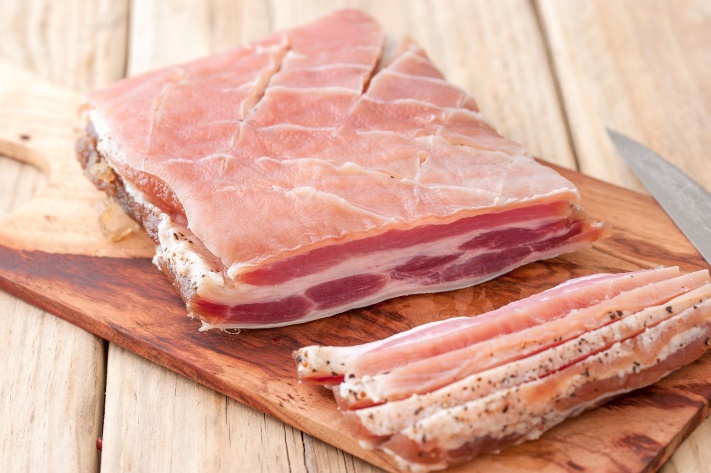 | 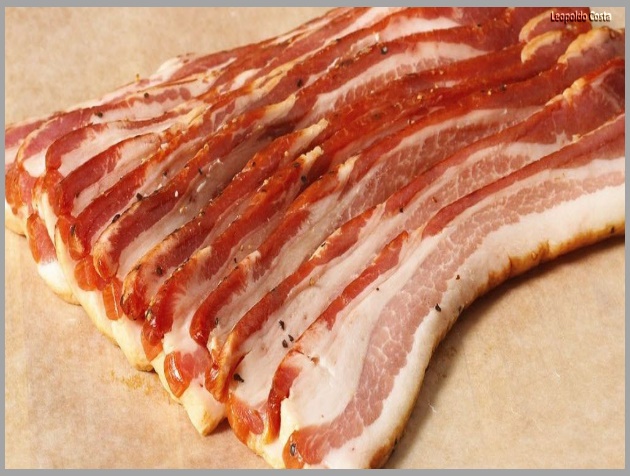 |
| Salt-cured & smoked bacon | Brine-cured & smoked bacon |
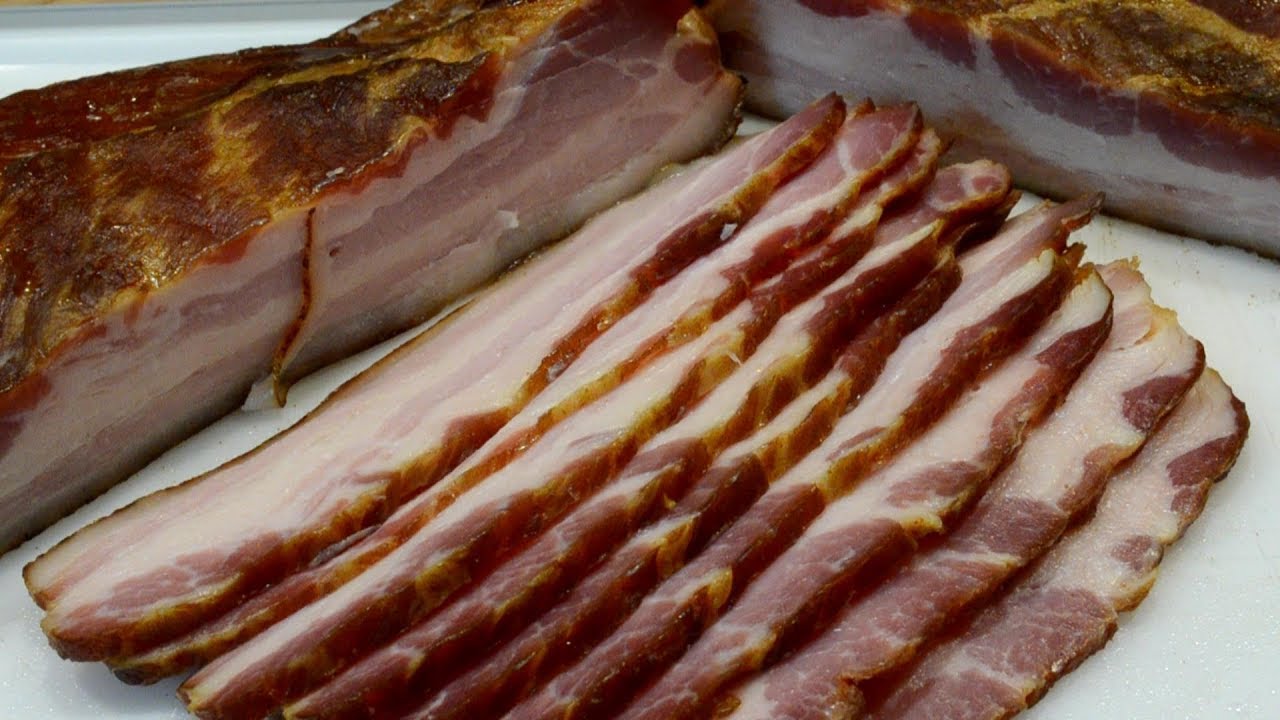 | 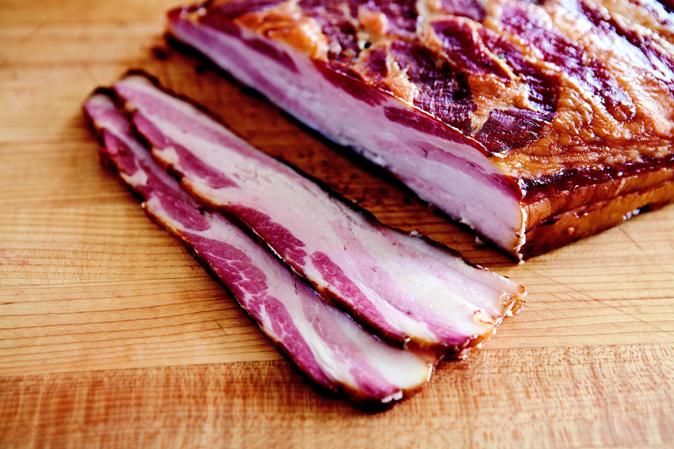 |
Types of Bacon-
There are dozens of variety of bacon are available in the Grocery store. Example of popular types of bacon are –
| Slab Bacon- Most bacon are already sliced However, some types of bacon can be unsliced. An unsliced section of cured pork belly is known as slab bacon. Slab bacon is typically sold with the rind still on, which we have to remove before cooking. | 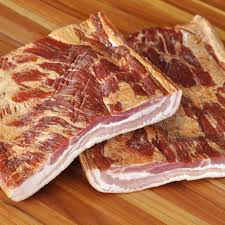 |
| UNCURED BACON Uncured bacon is bacon that hasn’t been cured with sodium nitrites. “Uncured” bacon has still been cured, but instead of synthetically-sourced nitrites, natural nitrates are used and converted into nitrites. These nitrates typically come from celery, beets or other produce that is naturally high in nitrates. Sea salt can also do the trick in some instances. | 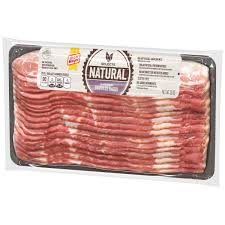 |
| SMOKED BACON Salt cured bacon that has been smoked heated to about 130 degrees F with specific kind of wood like cheery wood & various dry herbs | 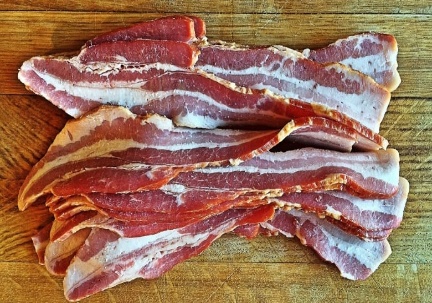 |
| Canadian bacon is an altogether different product from American bacon. In fact, it has more in common with ham than it does belly bacon. This is because Canadian bacon comes from a pork loin and contains far less fat than the pork belly. Canadian bacon as opposed to a fresh pork roast is that it is cured and smoked. | 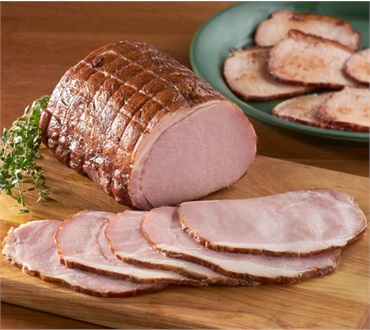 |
| Pancetta is another type of bacon worth mentioning. This Italian pork product has more in common with American-style bacon than Canadian bacon does because it is made from pork belly. The main difference between pancetta and bacon is that pancetta is only cured and not smoked. | 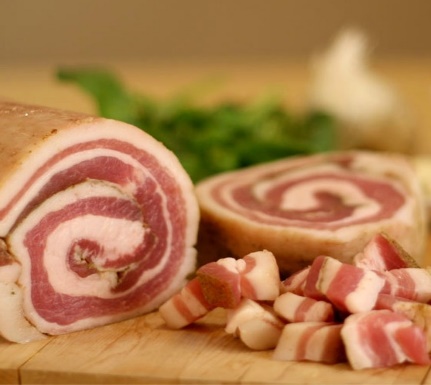 |
| Turkey bacon/Non Pork bacon It is made from Turkey instead of Pork meat curing the meat and smoking it, it comes out resembling bacon, but of course, a 10% fat content means significantly less flavor than pork bacon and a more rubbery texture. | 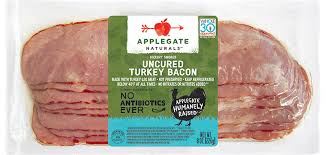 |
Nutrition and Benefits of Bacon
A standard cooked slice of bacon contains about 30 to 40 calories and 3.3 grams of fat per slice. The fats in bacon are about 50 percent monounsaturated and a large part of those is oleic acid—the same fatty acid that makes olive oil “heart-healthy.” Bacon is high in salt.
What is Gammon
“Both gammon and ham are cuts from the hind legs of a pig. Gammon is sold raw and ham is sold ready-to-eat,” Gammon has been cured in the same way as bacon whereas ham has been dry-cured or cooked. Gammon is cured by dry-salting or brining which may or may not be smoked.
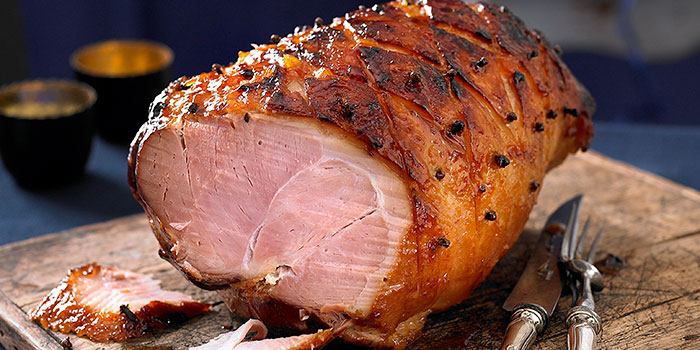
Ref:-
https://www.kitchenparade.com/2010/03/ham-101-what-to-know-before-buying-ham.php
